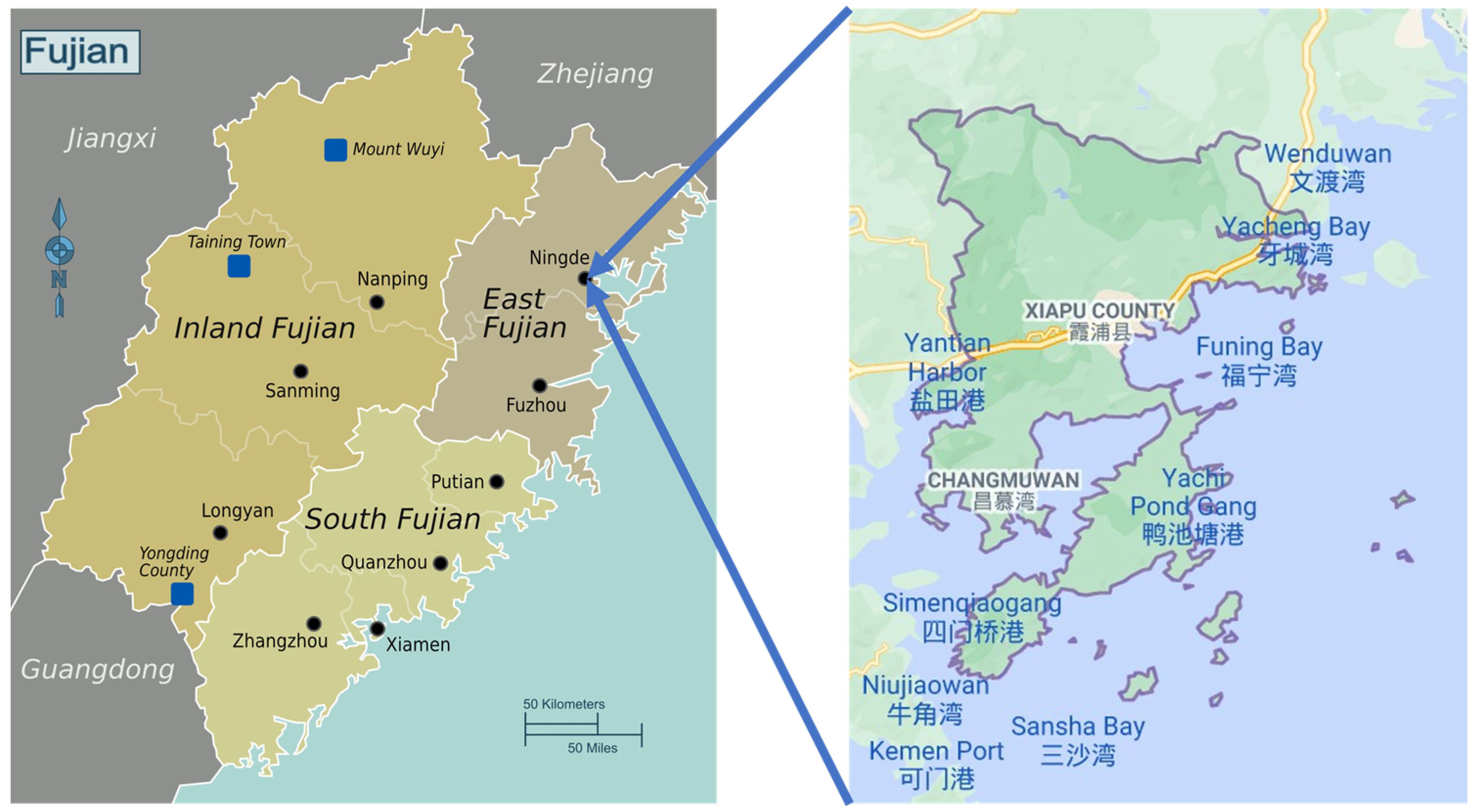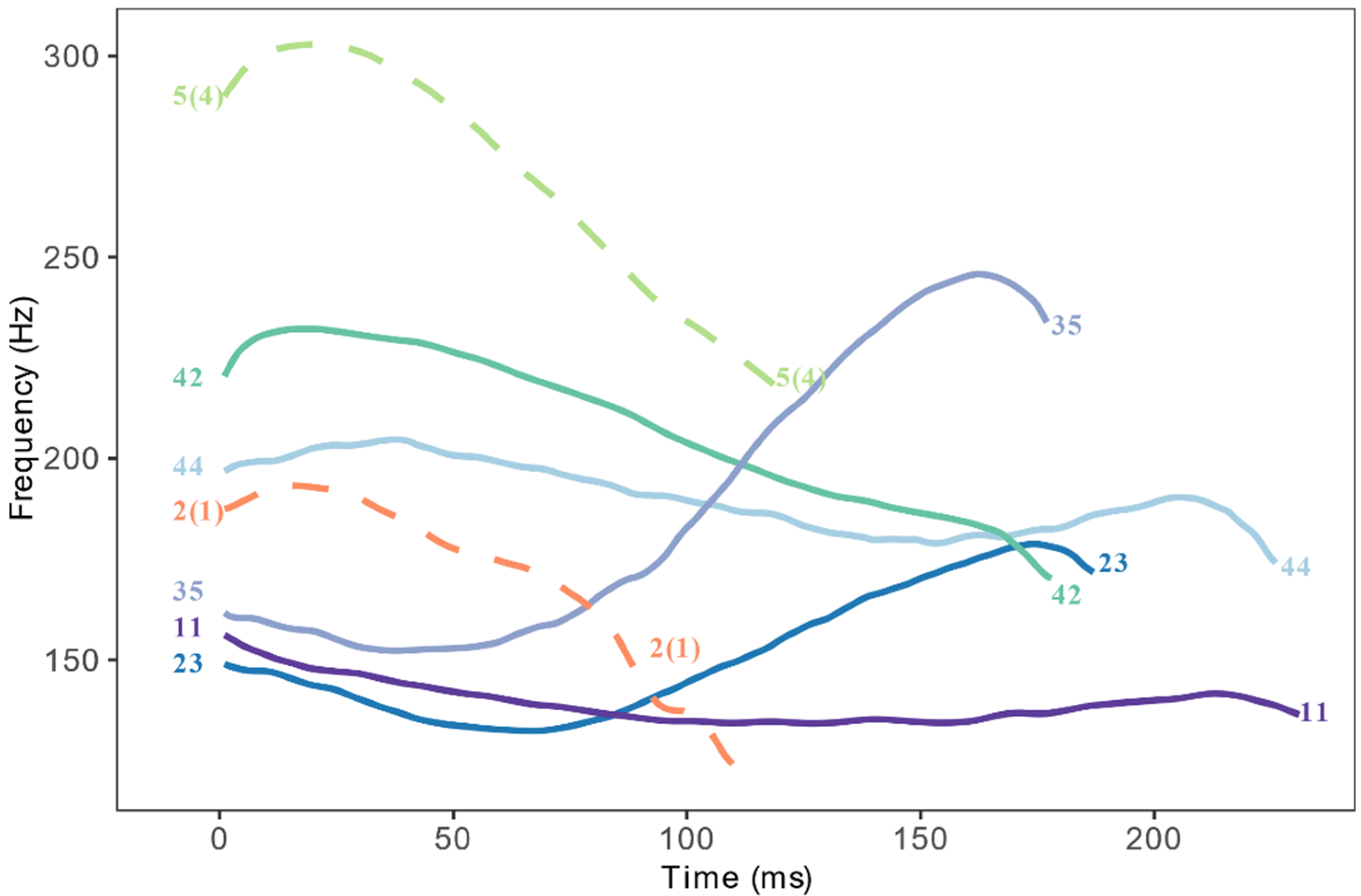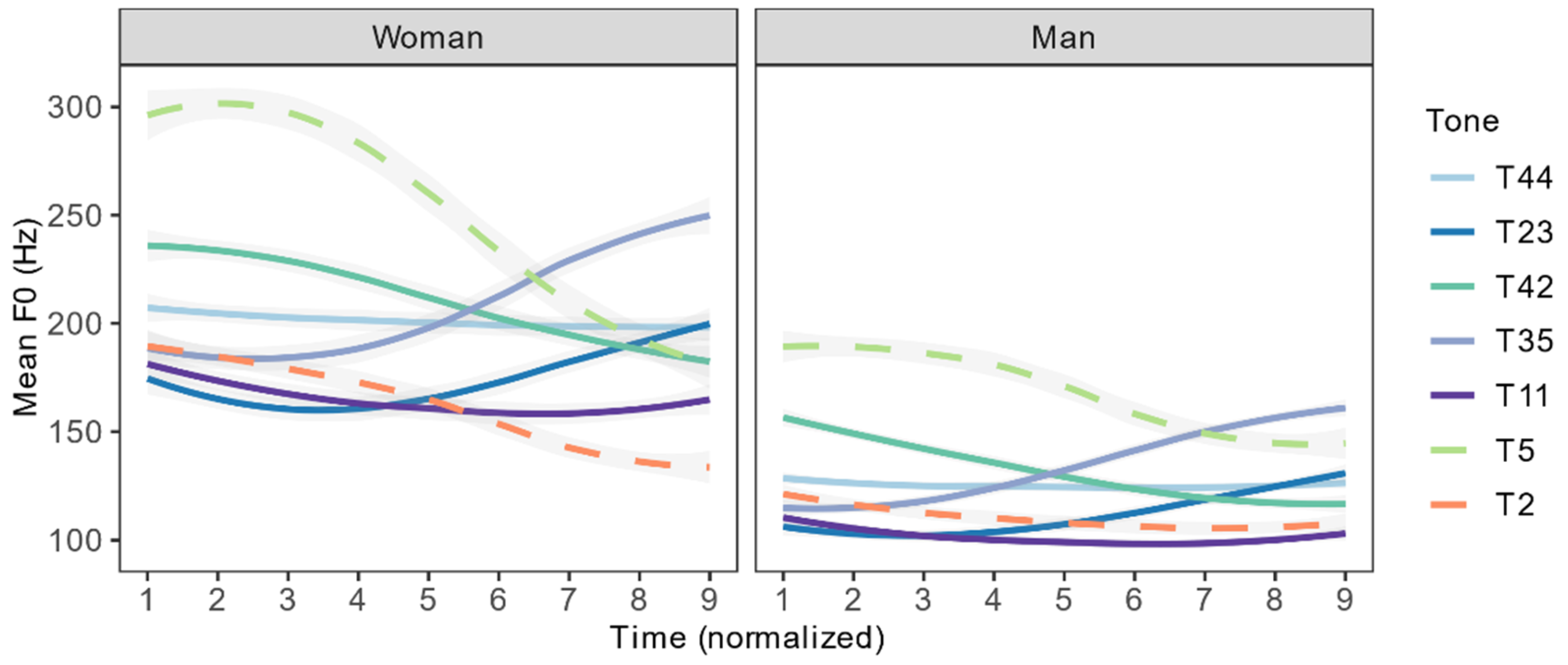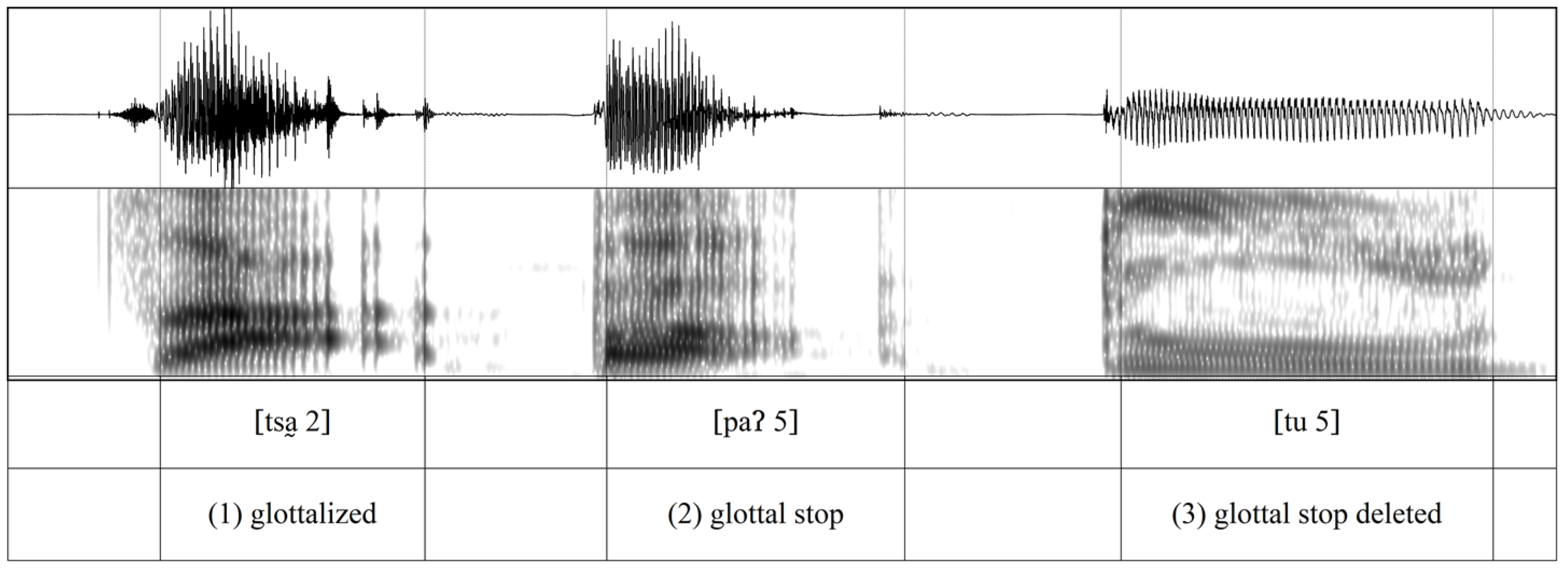The syllables that underwent sandhi in the compound words were the target syllables for this section. Ten participants produced 820 target syllables in total (41 compounds * two repetitions * ten participants). A total of 66 syllables were excluded because of either corrupted recording or mispronunciation, leaving 754 syllables valid for analyses. VoiceSauce (
Shue et al. 2011) yielded 79,100 data points in total. The tracking error and outlier detection and exclusion procedures were the same as described in
Section 3.2. After data exclusion, there were 78,960, 74,299, 74,299, 71,638, and 78,617 data points for F0, F1, F2, H1*–H2*, and HNR, respectively. The data points were divided into nine (for plotting the results) and three equally timed intervals (for the linear discriminant analysis). The descriptive statistics of the dataset can be found in
Tables S4–S7 in Supplementary Material S3.
4.2.1. Neutralization among T2, T44, and T23
The first sandhi rule of Xiapu Min is {T2, T23, T44} → T44 / ___ X (
Table 4, Example g). It results in a neutralization between T2, T23, and T44. We conducted Linear Discriminant Analysis (LDA) (
Izenman 2013) to investigate whether the neutralized tones can be categorized by the acoustic features before and after neutralization. LDA models use a categorical variable as the dependent variable, and they use multiple parameters that can potentially differentiate the categories in the dependent variable as the independent variables. By assigning different coefficients to different parameters, the model outputs at least one composite linear discriminant score for each token, and it uses that score to classify the categories. The number of linear discriminant scores equals the number of categories in the dependent variable minus 1. For example, when there are three categories to classify, the model outputs two linear discriminant scores, which are named first and second linear discriminant scores (LD1 and LD2). The purpose of using LDA models is to compare the classification results of the model with the true categories of the data and calculate the classification accuracy. If the classification accuracy is high, the parameters have effectively differentiated the categories in the input. The parameters that have a higher correlation with the linear discriminant scores are more effective for the classification. If the classification accuracy is at or below chance, the parameters have failed to differentiate the categories in the input. In this study, we used the percentage of the majority class as the chance level, because in random guessing, predicting all the tokens as the majority class results in the highest chance (
Bosch and Paquette 2018). The results of the LDA models can help determine whether the neutralization among the three underlyingly different tones is complete or not. The LDA models were implemented by the lda() function from the MASS package in R (
Venables and Ripley 2002).
The R code for the LDA models is in (8). The dependent variable is the citation tone of the target syllables. The independent variables are the average F0, H1*–H2*, HNR of three equally timed intervals of the vowels (F0_1, F0_2, F0_3, H1*–H2*_1, H1*–H2*_2, H1*–H2*_3, HNR_1, HNR_2, HNR_3) and the Duration of the vowel. We did not include vowel formants in the model because no difference in vowel formants was found in the citation forms of the target syllables.
We compared the three tones in citation forms (T2 vs. T44 vs. T23) in the same model. Since the acoustic differences among tones in sandhi forms are likely to be largely neutralized, comparing all three tones in sandhi forms in the same model could potentially obscure the fine-grained differences. Thus, we compared every two tones in sandhi forms (T23 vs. T44, T2 vs. T23, T2 vs. T44) in three separate models. The citation tones are distinguished by two LD scores. Each pair of sandhi tones is distinguished by one LD score. For every LDA model, we calculated its classification accuracy based on a leave-one-out cross-validation.
Figure 10a shows the LD1 and LD2 distribution of T2, T44, and T23 in citation forms. The classification accuracy of the citation forms is 94.81%, which is significantly higher than the 38.96% chance level (
p < 0.001). We applied the LDA models on each pair of contrasts between T2, T44, and T23 in sandhi forms to test the degree of neutralization between every two tones.
Figure 10b shows the LD1 distribution of each tone in each contrast. The classification accuracies of T23 vs. T44, T2 vs. T23, and T2 vs. T44 in sandhi forms are: 59.46% (
p = 0.31; chance = 54.05%), 68.69% (
p < 0.001; chance = 51.52%), and 76.61% (
p < 0.001, chance = 52.63%). The results indicate that the citation forms of T2, T44, and T23 are differentiated at near-ceiling accuracy. In sandhi forms, however, T23 and T44 are completely neutralized, whereas T2 and T23, and T2 and T44, can still be differentiated significantly above chance. Note that T23 and T44 are tested by only one minimal pair, whereas T2 vs. T23 and T2 vs. T44 are tested by three and five minimal pairs, respectively. The results for T23 vs. T44 may not be as representative as for the other two pairs. Future studies should aim for more balanced stimuli.
Next, we ask which acoustic parameters contribute most to the above-chance discriminations. We calculated the Pearson correlation between each acoustic parameter and the linear discriminant scores. For citation tones, LD1 explains 63.3% of the variance. The top three parameters that have the highest absolute correlation with LD1 are
duration,
mid HNR, and
final F0. For the discrimination between T23 and T2, the top three parameters that have the highest absolute correlation with LD1 are
duration,
final F0, and
initial H1*–H2*. For the discrimination between T44 and T2, the top three parameters that have the highest absolute correlation with LD1 are
duration, and
initial and final HNR. The statistics of Model (8) and the correlations between the parameters and the linear discriminant scores are presented in
Tables S17–S21 in Supplementary Material S3.
Figure 11 shows the values of F0, H1*–H2*, HNR, and the duration of T44, T23, and T2 in citation and sandhi forms. In terms of F0, the contours of the three tones are well dispersed in citation forms. In sandhi forms, all tones have a flat F0 contour. The F0 height of T44 is slightly lower than that of T23 and T2. In terms of H1*–H2*, checked T2 is produced with lower H1*–H2* than unchecked T44 and T23 in citation forms. T2 has a falling H1*–H2* contour. In sandhi forms, the H1*–H2* value of T2 increases and is between T44 and T23. The H1*–H2* contour of T2 is flat. In terms of HNR, the HNR of T2 is lower than T44, but similar to T23 in citation forms. In sandhi forms, the difference in HNR among those three tones remains, but it becomes much smaller. The HNR of T2 and T23 increases. We compared the H1*–H2* and HNR of T2 between citation and sandhi forms using mixed-effects models and confirmed that the increases in both parameters after sandhi are significant. The statistics are in
Tables S22 and S23 in Supplementary Material S3. In summary, checked T2 has a constricted and noisy quality in citation forms. In sandhi forms, T2 becomes less constricted and less noisy, indicating a reduction of glottalization. The duration of T2 is shorter than that of T44 and T23 in both citation and sandhi forms. The duration of T2 is shorter in sandhi forms than in citation forms, possibly because a sandhi form is at the position of the initial syllable in a disyllabic compound word, whereas a citation form is a monosyllabic word itself.
4.2.2. Neutralization among T5, T42, and T35
The other sandhi rule of Xiapu Min is {T5, T42, T35} → T55 / ___ X (
Table 4, Example h). It results in the neutralization of T5, T42, and T35. Similar to
Section 4.2.1, we performed LDA in this section to determine whether the neutralization between those three tones was complete or not. The R code was the same as in Formula (8). For every LDA model, we calculated its classification accuracy based on a leave-one-out cross-validation.
We compared the three tones in citation forms (T5 vs. T42 vs. T35) in the same model.
Figure 12a shows the LD1 and LD2 distribution of T5, T42, and T35 in citation forms. The classification accuracy of citation forms is 100%, which is significantly higher than the 45.57% chance level (
p < 0.001). We applied the LDA models on every two contrasts of T5, T42, and T35 in their sandhi forms.
Figure 12b shows the LD1 distribution of each tone in each contrast. The classification accuracies of T35 vs. T42, T5 vs. T35, and T5 vs. T42 in sandhi forms are: 47.41% (
p = 0.83; chance = 51.11%), 80.35% (
p < 0.001; chance = 51.45%), and 86.79% (
p < 0.001, chance = 53.77%). The results indicate that, before sandhi, the citation forms of T5, T42, and T35 are differentiated at ceiling accuracy. After sandhi, T35 and T42 are completely neutralized along these measures, whereas T5 and T35, and T5 and T42, can still be differentiated significantly above chance.
We calculated the Pearson correlation between each acoustic parameter and the linear discriminant scores to determine which parameters contribute most to the above-chance discriminations. LD1 explains 91.9% of the variance of the citation tones. The top three parameters that have the highest absolute correlation with LD1 are
initial and mid F0, and
duration. In both discriminations between T5 and T35 and between T5 and T42 after sandhi, the top three parameters that have the highest absolute correlation with LD1 are
duration, and
initial and mid HNR. The statistics of Model (16) and the correlation between all the parameters and the linear discriminant scores are presented in
Tables S24–S28 in Supplementary Material S3.
Figure 13 shows values of F0, H1*–H2*, and HNR of T42, T35, and T5 in citation and sandhi forms. In terms of F0, the three tones have well-dispersed contours in citation forms. In sandhi forms, their F0 contours become flat and are largely overlapping. In terms of H1*–H2*, in citation forms, checked T5 overlaps with T42 and T35 in the first two-thirds of the vowel, and it has lower values than T42 and T35 in the last third. In sandhi forms, checked T5 has overall higher H1*–H2* than T42 and T35, and it ends in a similar value as T42 and T35. On average, the H1*–H2* value of checked T5 has increased after sandhi. In terms of HNR, in citation forms, T5 overlaps with T42 and is higher than T35 in the first two-thirds of the vowel, and it has lower values than T42 and T35 in the last third. In sandhi forms, T5 has lower HNR than T42 and T35 in general. However, on average, the HNR value of T5 has increased after sandhi. In addition, in citation forms, the HNR of T5 has an abrupt fall after Point 4. In sandhi forms, the HNR of T5 has an overall rising contour, and there is a slight fall after Point 7. The final HNR value of T5 is higher in sandhi than in citation forms. We compared the H1*–H2* and HNR of T5 between citation and sandhi forms using mixed-effects models and confirmed both parameters have significantly higher values in sandhi forms than in citation forms. The statistics are presented in
Tables S29 and S30 in Supplementary Material S3. In summary, checked T5 has a constricted quality and a noisy ending in citation forms. In sandhi forms, T5 becomes less constricted and less noisy, indicating a reduction of glottalization. The duration of T5 is shorter than T42 and T35 in citation and sandhi forms. The duration of T5 is shorter in sandhi forms than in citation forms.
4.2.3. Summary of Tonal Neutralization in Sandhi Forms
Table 9 summarizes the classification accuracy of each neutralized contrast and the top three acoustic parameters that have the highest correlation with the linear discriminant scores. Among the six neutralized pairs T23-T44, T2-T23, T2-T44, T35-T42, T5-T35, T5-T42, four of them are not completely neutralized phonetically: T2-T23, T2-T44, T5-T35, and T5-T42. All four of those pairs involve a checked and an unchecked tone. The neutralizations between unchecked tones are all complete. According to the LDA results, duration is the primary acoustic correlate that distinguishes checked tones from unchecked tones in sandhi forms.
Table 10 presents the average duration of each tone in citation and sandhi forms. Checked tones remain shorter than unchecked tones in sandhi forms, though the percentage of checked tone duration to unchecked tone duration increases slightly compared with the citation forms (citation: 66%; sandhi: 70%).
Among all the sandhi forms, F0 (of the last third of vowels) surfaces as an important correlate only in distinguishing T2 from T23 (
Table 9). However, the correlation between F0 and LD score is rather weak (Pearson
r = −0.31). The absolute difference in final F0 between T23 and 2 is 8 Hz, which is rather small. Thus, we conclude that the F0 difference among checked and unchecked tones in citation forms is largely neutralized in sandhi forms.
Moreover, H1*–H2* (of the first third of vowels) surfaces as an important correlate only when distinguishing T2 from T23 in sandhi forms (
Table 9). However, the correlation between H1*–H2* and the LD score is also rather weak (Pearson
r = 0.25). In citation forms, the H1*–H2* contour of checked tones is in a falling trend (
Figure 5,
Figure 11 and
Figure 13). Checked T2 and 5 end in significantly lower H1*–H2* than unchecked tones. In sandhi forms, however, the H1*–H2* contour of T2 and 5 becomes flatter. The H1*–H2* of T2 is higher than T44. The H1*–H2* of T5 is higher than T35 and 42. Given that a higher H1*–H2* value is correlated with less glottal constriction, we argue that checked tones in sandhi forms become less constricted, especially at the end of vowels, compared with the citation forms. The difference in glottal constriction between checked and unchecked tones is largely neutralized in sandhi form.
Finally, HNR appears to be an effective parameter when distinguishing T2 from T44, T5 from T35, and T5 from T42 (
Table 9). However, for T2 vs. T44, the difference in average HNR becomes smaller in sandhi forms than in citation forms (citation: 15.12 dB; sandhi: 4.88 dB). For T5 vs. T35 and T5 vs. T42, their difference in HNR is in the initial and middle third of the vowel, but not at the end. In contrast, in citation forms, checked T5 is characterized by its steeper falling HNR contour during the latter half of the vowel.
One possible explanation is that HNR differences between T5 and T35 and 42 in the initial two-thirds of the vowel are a by-product of the short duration and the influence of the onset in the checked tones. Three-quarters of the target syllables in the stimuli have a voiceless aspirated stop (/tʰ/), voiceless affricate (/ts/), or voiceless fricative (/x, θ/) as the onset. Thus, it is possible that the aspirated and fricated onsets introduce noise into the vowels. Additionally, it may also be because vowels bearing checked tones in sandhi forms are extra-short compared to those with unchecked tones (both in citation and sandhi) and to those with checked tones in citation forms. It is possible, then, that checked tones in sandhi forms might be more affected by the onset noise than other tokens because their vowel duration is too short to gain periodicity after the noisy onset. Considering the artifact brought on by the onset, and the fact that average H1*–H2* and HNR values of checked tones increase after sandhi, we suggest that the vowel-final glottalized quality of the checked tones is largely reduced in sandhi forms. In summary, in citation forms, checked tones are differentiated from unchecked tones by having distinct F0 contour, shorter duration, and glottalized quality at the end of the vowels. In sandhi forms, checked tones acquire similar F0 values and phonatory quality to unchecked tones. However, the duration difference between checked and unchecked tones persists.





















